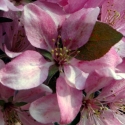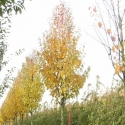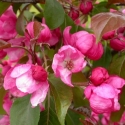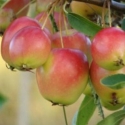Malus
PAGE 1 2 3 4 ALL Beautiful in spring with a bountiful display of fragrant deep pink blossom that is followed by ornamental purple-red fruit. The foliage is red toned and intensifies in colour prior to leaf fall. A highly ornamental tree with a narrow pyramidal habit. Plant in a sunny spot. Est.10yr.growth.
Malus Crabapple Strathmore Current Stock Height: 150/190cm ? $69.99 Malus Crabapple Strathmore Current Stock Height: 140/160 cm ? Container: 8l ? $74.99 aka Asian Crabapple A unique species from Asia with very distinctive maple-like leaves that are glossy green in summer and turn a vivid range of orange and scarlet shades in autumn. Large clusters of single white flowers in spring are followed by pear shaped fruit of greenish yellow flushed with red. Deciduous Malus Crabapple Trilobata Current Stock Height: 120/140 cm ? Container: pb18 ? $74.99 aka Japanese Chonosuki Crabapple A highly ornamental Japanese species with a strong erect, narrow habit. White/pink spring blossom followed by new silvery green foliage, changing to glossy green in summer and spectacular copper-yellow shades in autumn. The small 'apples' are green flushed with red. Deciduous. Malus Crabapple Tschonoskii Current Stock Height: 100/120 cm ? Container: pb18 ? $74.99 A popular cultivar for smaller gardens or container growing due to its narrow columnar habit. The pink spring blossom opens from tight scarlet buds and is followed by bright yellow 'apples' that are blushed with red. Hardy, tolerant and disease resistant. Deciduous. Malus Crabapple Van Eseltine Current Stock Height: 190/240 cm ? Container: pb18 ? $74.99 A superb Crabapple bred in NZ and named after Mr Hayward Wright. Beautiful white blossom in spring followed by a plentiful supply of large crimson fruits that hold on the tree through winter. Wine coloured foliage late Summer
- Autumn. Prefers a sunny well drained position. Deciduous.
Malus Crabapple Wrights Scarlet MM106 Current Stock Height: 130/150 cm ? Container: 8l ? $74.99
Habit: Upright
Leaves: Deciduous, Red
Mature Size 7-10 yrs (HxW): 3m x 1.5m
Taller growth habit and very worthwhile for many situations.
Habit: Upright
Leaves: Deciduous, Green
Mature Size 7-10 yrs (HxW): 4.5m 
Habit: Upright
Leaves: Deciduous, Green
Mature Size 7-10 yrs (HxW): 10m x 4m
As a general rule Crabapples are more tolerant of adverse soil conditions than other blossom trees and are long lived and hardy. They will do their best planted in the sun in well drained soil.
Habit: Columnar
Leaves: Deciduous, Green
Mature Size 7-10 yrs (HxW): 3m x 1.5m
Habit: Upright
Leaves: Deciduous, Red
Mature Size 7-10 yrs (HxW): 3 x 3m
HL Nurseries Limited t/a Wairere Nursery
826 Gordonton Road, R D 1, Hamilton 3281 Ph: (07) 824 3430 Email: